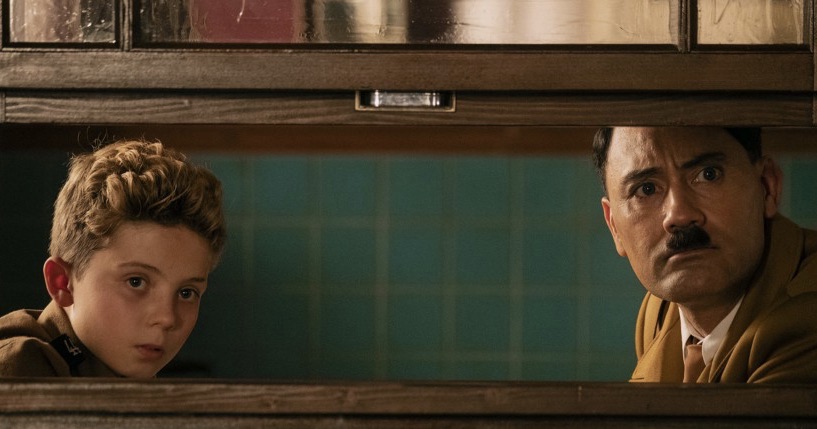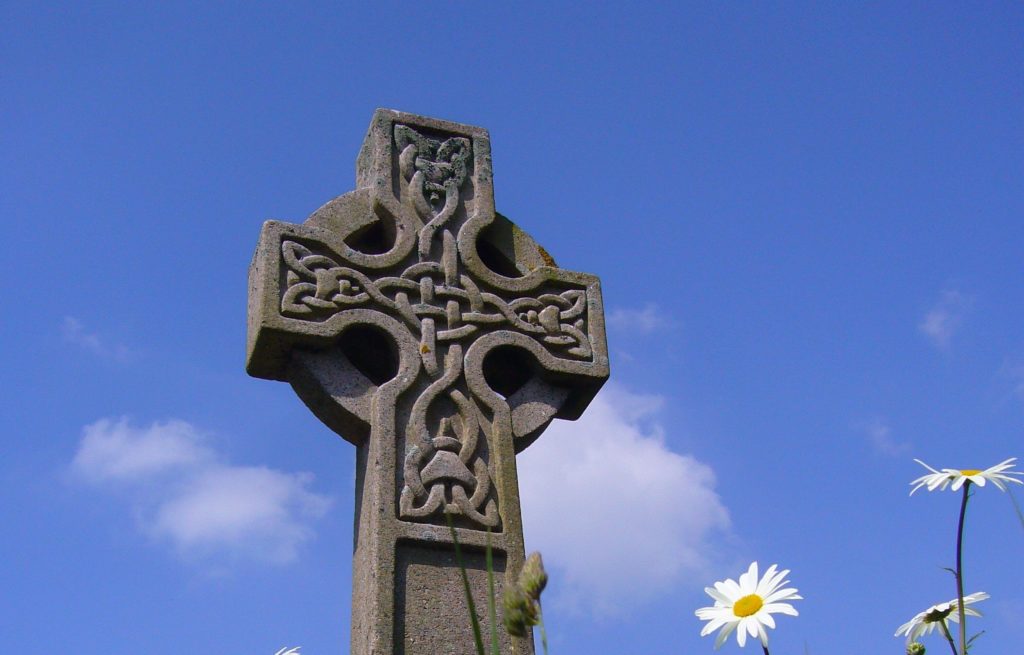Recently, I found myself watching a Catholic priest inadvertently do an impersonation of Adolf Hitler and infuriate a group of his Chinese neighbours, because an inexplicably ridiculous ‘perfectly square bit of black dirt’ appeared in his living room window, placed at such an angle as to lend him the trademark moustache necessary for him to take on the countenance of the Fuhrer. If this sounds implausible, it’s because it is. If it sounds familiar, perhaps you have seen it too – it’s a famous scene from the 90s Irish sitcom Father Ted, which has since amassed a cult following. Viewed in isolation, this scene may make you hesitant to laugh – what’s funny about ignorance and absurdity culminating in a crude Hitler impression? However, you might look on the scene more favourably, with a wry smile or even – dare I say it – actually laugh out loud, when taking into account some of the context.
The scene is deeply ironic in that the very reason Father Ted’s neighbours are so quick to believe that he is impersonating Hitler is because they have already seen him do a racist Chinese impression by placing a lampshade on his head and tugging at the skin around his eyes when he thought no one was watching (not quite conducting himself with appropriate levels of decorum given his vocation, one might say). The audience laughs at the moustache scene because we know that, for all of Ted’s indignance at being seen as a racist – at being seen attempting to emulate Hitler, no less – he actually is one. We also know that lurking elsewhere in the background of the episode is another priest who really is a Nazi fanatic, and collects Nazi memorabilia for his shrine to the Third Reich. The image of a priest’s collar juxtaposed with a Hitler moustache is deliberate and savage: the show gets its laughs by routinely and ruthlessly mocking the institution that is the Roman Catholic Church.
Many films and television shows have looked to satirise Nazism, sometimes using this as a vehicle to interrogate and criticise other institutions (as in this instance with Father Ted), and sometimes simply to expose the absurd underbelly of fascist ideology. This has happened with varying degrees of intelligence and success, but it’s nonetheless something embedded in our popular culture and isn’t going anywhere any time soon: as recently evidenced in the huge commercial success of Academy Award-winning comedy-drama film Jojo Rabbit, set in Germany during the final months of the Second World War, and directed by self-described Polynesian Jew, Taika Waititi. The release of Jojo Rabbit coincided with the 75th anniversary of the end of the War, and more specifically, Holocaust Memorial Day, which was observed on the 27th January 2020. The timing of this release spawned a number of think pieces and reviews fixated on the film. Whether the film was funny, well-written, and/ or well-acted or not was not the point of contention. Rather, given the context of the anniversary, and at a time when antisemitic attacks are disturbingly on the rise in the western world, critics were in fierce disagreement over the question of whether it is ever appropriate to laugh at all at a film that takes Nazism as its subject.
The pressure to memorialise the Holocaust is becoming graver as first-hand accounts are rapidly disappearing from living memory. The loss of Holocaust survivors and their testimonies as more members of that generation pass on is a source of acute anxiety for many, and with good reason. It was gloomily reported in The New York Times that over the past five years, almost half of all Holocaust survivors have died. Some 120 survivors from around the world attended a ceremony at Auschwitz to commemorate the 75th anniversary of the camp’s liberation this year. Many of them have dedicated their lives to preserving the memory of what happened, and a number of moving speeches were made to an audience of world leaders who had gathered for the occasion. These often manifested as tearful and visceral, invariably amounting to an oft-used but relevant-as-ever plea: never again.
Get the best of Moxy directly in your inbox.
Scathingly, Howard Jacobson wrote in The Guardian that Jojo Rabbit is in danger of betraying the dead by representing a ‘feel-good Holocaust’ and accused the film of being ‘kitsch’. This take was presumably inspired by not just the comedic element to the film and Waititi’s distinctive aesthetic style, but the fact it has a happy ending (spoiler: an aspiring Hitler youth has a change of heart about his antisemitism after discovering his mother belongs to the resistance and he slowly befriends a Jewish girl she has been harbouring in their attic). A. O. Scott similarly pointed out in The New York Times that humour alone is ineffective in dismantling fascism, and that ‘authoritarian leaders prove impervious to satire’.
These criticisms gave me pause for thought about the entertainment value of such a film, particularly in our current political climate. The humour employed by flocks of Remain voters during and after the Brexit referendum, which was often thinly veiled class warfare, did not prevent Brexit from coming to pass in the United Kingdom. Mocking Donald Trump for his pumpkin complexion and bad hair did not stop him from becoming the President of the United States of America, passing damaging legislation against women’s self-autonomy, and locking immigrant and refugee children in cages. Cajoling Boris Johnson on social media for his ‘colourful’ (read: odious) personal life has not prevented tens of thousands of people dying from coronavirus after the British government failed to take the threat seriously. Nor do farcical depictions of racists such as that of the Ku Klux Klan as incompetent and immature in Quentin Tarantino’s Django Unchained undermine the very real threat that white supremacy poses to Black people, no matter how funny. Continuing to poke fun at such events has done nothing to diminish their reality. If anything, the relationship between humour and outrage can lead to heavy publicity. The relentless media focus on Trump during his candidacy in 2016 not only kept him at the forefront of the public imagination and popular culture but also allowed some sectors of the American public to become desensitised to the extremity of his views.
When I attended the London Black Lives Matter protests outside the US embassy and in Parliament Square in June to demonstrate contempt for the inadequacy of the UK government response to what was happening both at home and overseas, I was mindful that I had seen dozens of social media posts from Black activists discouraging non-Black allies from using humorous slogans on their protest signs, saying that this wasn’t the time for the quips and puns that had gone viral at the Women’s March and various marches against Brexit and Trump. With the added reality of the pandemic and the associated controversies inherent in making the decision to take to the streets at all, this seemed wise. I attended the protests with a Jewish friend who wrote on her sign ‘Never Again means Black Lives Matter’. One person I mentioned this to at the time expressed discomfort at this phrase, viewing it as an equivocation between two different kinds of collective trauma. This is not an uncommon reaction: the idea of collective traumas such as the Holocaust and colonialism being in competition with one another is one that is hotly debated in some quarters. For my friend, however, it was a powerful expression of solidarity, and, crucially, an opportunity to level vocal opposition and criticism to a system of oppression that would otherwise seek to silence.
‘Never again’ is not a concept to be trivialised, and cute protest signs are not a meaningful form of opposition. I, too, think about how we are to honour the survivors that implore ‘never again’ when I consider a valid question posed by Anthony Lane in The New Yorker upon his viewing of Jojo Rabbit. Referencing the harrowing scene in which Jojo discovers that his mother has been murdered by the gestapo for her role in the resistance, Lane asks, ‘How are we supposed to laugh—can we still laugh—when we’ve just seen corpses swinging from the gallows in a town square?’
∆
Margaret Atwood famously wrote that men are afraid that women will laugh at them, and that women are afraid that men will kill them. It is true that much of contemporary chauvinistic ‘incel’ culture, especially as it exists online, is rooted in the male fear of ridicule. Ridicule can be a powerful tool for undermining patriarchal hegemony, as generations of feminists can attest to, but ironically ridicule can also create and inspire misogyny. Humour is not only weaponised against fascism or extremist regimes, and the alt-right internet has also used humour as a tactic in its criticisms of democratic regimes and centrist political thinking. The same is true of fascism in Jojo Rabbit. Waititi wants viewers to ridicule Nazi ideology, but it is no coincidence that it is humiliation at the hands of a group of Hitler Youth bullies in the opening sequence to the film, after he is made fun of for refusing to snap the neck of a rabbit, that motivates Jojo to seek refuge in the personality cult of the Fuhrer and instate Hitler as his imaginary friend. Ridicule has the power to be wielded in many directions, and humour cannot be policed as a form of political commentary reserved for one kind of political view.
However, it is in that context in which I think it is important to recognise that the film’s humour takes aim at fascist ideology, not at war or death or at the Holocaust itself. Nearly all comedic moments in the film are centred on Hitler’s cult of personality and the ludicrousness of antisemitic propaganda. Further, the film pivots dramatically from these comedic moments to a dangerous tension between Jojo and Elsa (the Jewish girl his mother is protecting, and who slowly changes his perception of Nazism). The retorts against Jojo’s antisemitism delivered by Elsa are electric and affecting. As she holds him in a headlock after he threatens her, she whispers, ‘There are no weak Jews. I am descended from those who wrestle angels and kill giants’. Her character serves to restore Jewish dignity, to humanise, and to inspire empathy, not to present us with the worst of what happened to Jewish girls during the war. Perhaps most frequently in Holocaust narratives, we see stories of the camps, but Jojo Rabbit is a fictionalised exploration of a narrative rarely heard outside of the famous story of Anne Frank and her family: that of those who went underground. Of the 180,000 Jews living in pre-Nazi Berlin, around 7,000 still remained as late as 1943, at which point they largely went into hiding. Even more remarkably, when Berlin was conquered in 1945, 1,700 Jews had survived and came out of hiding. As Gabriella Geisinger puts it in Digital Spy: ‘rightfully we never go to the death camps. We never see the piles of shoes, the messy reality of the consequences of [antisemitic] blame. The blame is not the story Jojo Rabbit is telling, and that’s okay’.
I’m confident that other reviewers such as Jacobson knew full well that no one, upon viewing this film, would be laughing at any of the moments that did speak to the atrocities that occurred. When I watched this film at a relatively busy showing (and incidentally with the same Jewish friend at a cinema in North London), no one was laughing at the dead bodies hanging in the town square. No one was laughing at a child losing his mother, no one was laughing at the plight of a Jewish girl hiding in an attic, and no one was laughing when her papers were inspected – in fact the audience tangibly held their breath at that moment. And finally, while everyone laughed indulgently at Captain K’s flamboyant and surrealist battlefield costume, no one laughed when he sacrificed himself to save a ten-year-old boy. Perhaps we should trust audiences more.
Muriel Spark argued that ‘Ridicule is the only honourable weapon we have left […] we must all be educated and conditioned to regard violence in any of its forms as something to be ruthlessly mocked’. The question of whether ridicule is a worthy weapon or not against far-right ideology is coming under scrutiny elsewhere. In a viral YouTube video earlier this year, it emerged that the far-right British commentator Katie Hopkins had been subjected to an astonishingly elaborate prank in which she was flown out to Prague and tricked into accepting a fake award for her services to freedom of speech. She was then photographed with the word ‘c*nt’ magnified on a screen behind her. Many viewers (myself included!), felt some degree of pity for Hopkins, who had fallen prey to an excruciatingly detailed exercise in humiliation. That pity lasted until it was time for her acceptance speech, which also ironically deployed an attempt at humour; in her case, a racist, ableist, one-woman stand-up show.
Regardless of the ethical dilemmas posed by such acts, it is significant that satire often holds many real-life consequences for its creators. Writing about the prank on Hopkins for Metro, Inigo Laguda asked in the same vein as Scott, ‘when will we realise that bigotry can’t be ridiculed into obscurity?’ The truth is, it would be foolish to suggest that there is no power in an art form which has prompted terrorist attacks, such as that on the satirical weekly newspaper Charlie Hebdo in Paris, which directly resulted in the murders of twelve people. This is not to blindly defend an abstract concept of freedom of speech when many extremists have used that same platform to try and take it down or to enable hate speech. On the contrary, it is about defending democracy in times when humour can be an inherently political act: in 2020, there are still countries in the world where to joke about the ruling dictator can lead to state-sanctioned execution. Humour, then, while not always able to undermine political systems so as to topple them, is still regarded as a powerful enough form of resistance that authoritarian regimes seek to censor it.
What’s more, whether humour can affect change or not is perhaps not the only reason it has value. In a 2010 essay titled: ‘Laughter in a Time of Tragedy: Examining Humour during the Holocaust’, Whitney Carpenter tells of how in the concentration camps, ‘[h]umour played a large role in mental survival and stability’. I believe this holds true across many scenarios. Gallows humour featured heavily in my family as my mum’s death from a terminal illness approached, and we knew that laughter would be our last shared pleasure. Several months ago, a poignant video clip went viral on Twitter, featuring a Syrian man named Abdullah Mohammad, who was teaching his toddler to laugh at the sound of bombs. He did this in order build his daughter’s mental resilience to the relentless instability of her environment and enable her to use this humour as a coping mechanism amidst the trauma of growing up in a conflict zone. I should hope that no one would look to deny them that laughter in the face of cruelty, injustice, and war. Laughter often provides a final refuge in times of severe turmoil and distress, as many people will no doubt be experiencing during this present moment as our individual worlds shrink and shake from a global pandemic. Laughter can be a crucial method of commiseration and comfort.
To say that Jojo Rabbit deployed humour and comedy with sensitivity is not to say that satire is a supreme art form and the only way to tell a story. It is just one way, but it is important that it exists, and significantly, it has existed for some time, with Mel Brooks’ The Producers (1967) perhaps being the most famous example of a satirical black comedy film that looks to humiliate Nazism. Jojo Rabbit utilised this comedy to starkly contrast with the darker moments in its narrative, not to make light of the subject in general.
There are many forms of remembrance, most (rightly) humourless. Remembrance occurs when we visit museums; when we send our children on class trips to the trenches of Passchendaele and to the sites of mass graves, as happened when I was at school; and when we ensure that the Holocaust is a compulsory facet of the education curriculum. We also enact remembrance when we wear red poppies every November – although the British preoccupation with the red poppy has become heavily politicised, and in recent years many have understandably begun to question whether poppy culture is still about remembrance or whether it has become a vehicle for celebrating militarism. Remembrance occurs in virtually every art form, and music, memoirs, novels, documentaries, and films have been created with the sole purpose of embedding the Holocaust narrative in the collective western imagination. Some of these works will have flashes of humour, such as Art Spiegelmann’s epic graphic novel Maus, which was similarly at the receiving end of criticism for utilising an unconventional medium in order to tell a story about the Holocaust. Humour is part of our humanity, and if the Holocaust narrative exists to teach us anything, it is about the extremes and contradictions of humanity.
Jojo Rabbit is not a film about the Holocaust or about the military action that took place during the Second World War. There are many mediums that examine those events to startlingly serious effect, as there should be. Jojo Rabbit is a film about innocence, about indoctrination, and about the capacity of a child to love or hate depending on their environment. It is not even a comedy film or entirely satiric; it’s a comedy-drama film blending absurdism with realism. Some expressed concern that the film risked empathising with Nazis by showing us how a child might become one; my argument in return is that such empathy is crucial to our understanding of how and why people were seduced by such a hateful ideology in the first place. Although education can be both welcomed and resisted (understanding is no guarantee that we will not fall for hateful ideologies ourselves), it remains a prime way to honour our commitment to that haunting refrain: never again.





